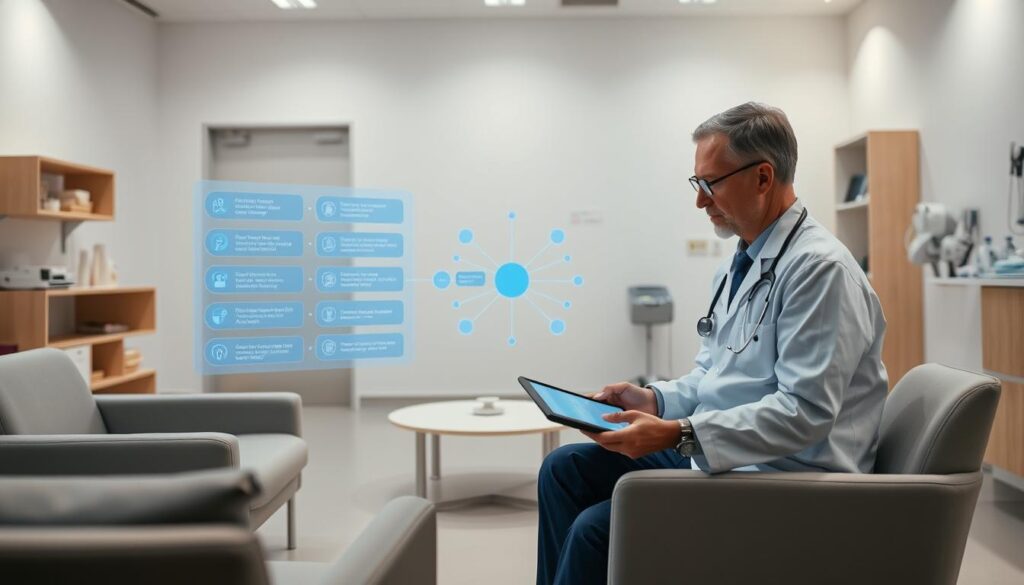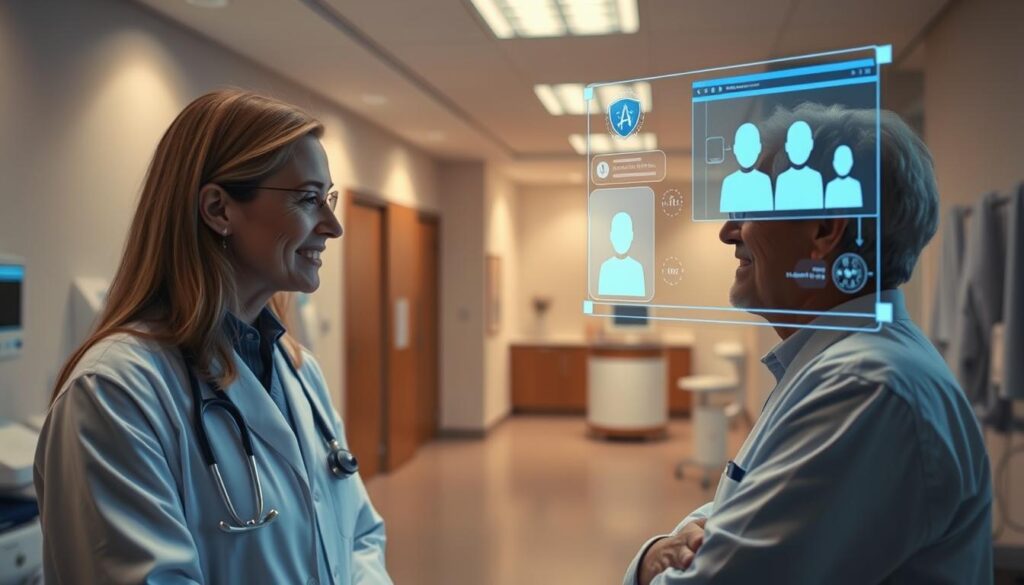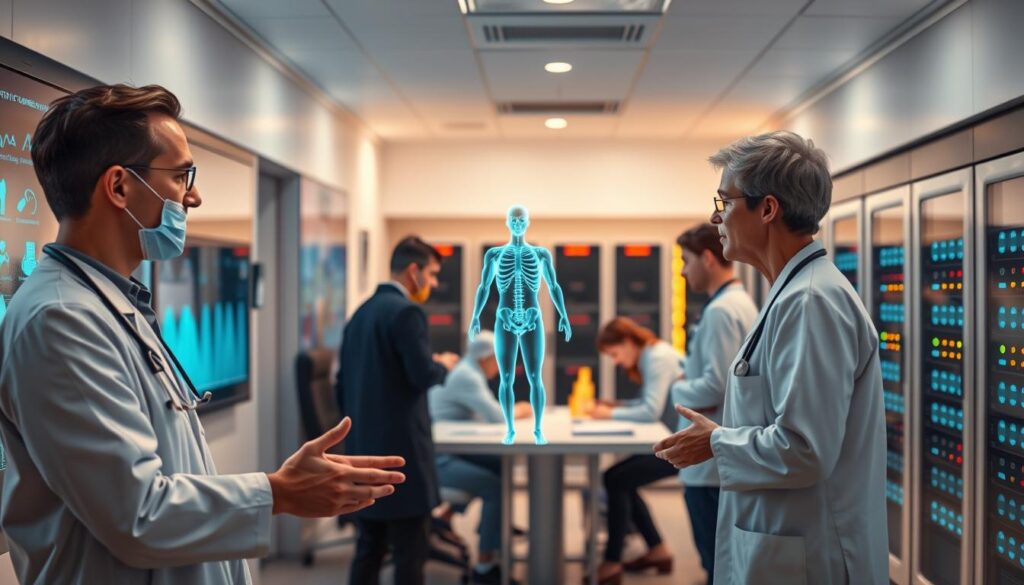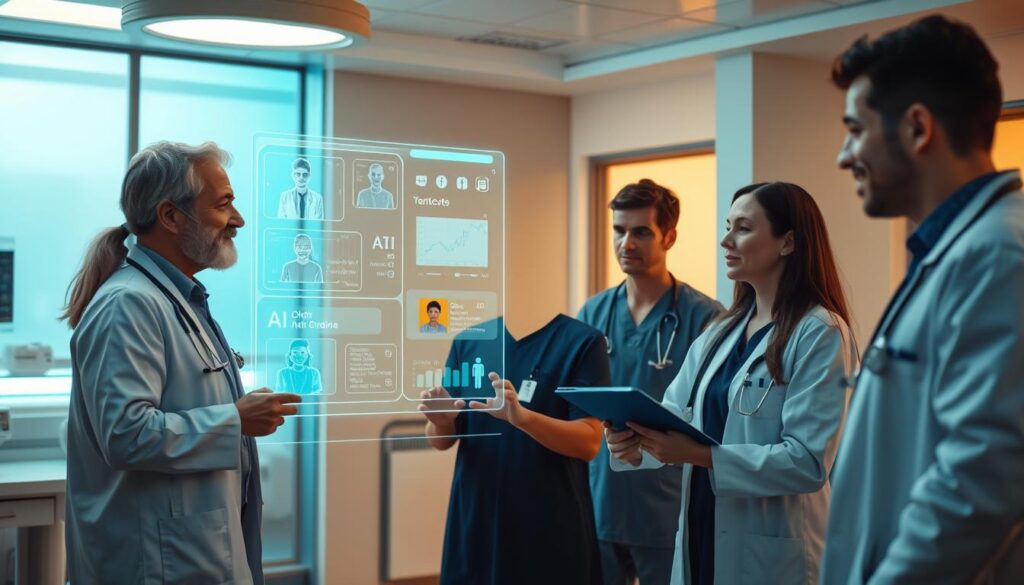“Technology is nothing. What’s important is that you have faith in people, that they’re basically good and smart, and if you give them tools, they’ll do wonderful things with them.” – Steve Jobs. This sentiment rings true as artificial intelligence reshapes how patients and providers interact, fostering better communication and improved outcomes.
Artificial intelligence tools like ChatGPT and machine learning platforms are redefining healthcare systems. They enhance diagnostic accuracy, streamline scheduling, and enable real-time communication. For instance, Google’s prediction models and IBM Watson Health showcase tangible benefits in clinical decision support1.
These advancements not only improve patient care but also boost operational efficiency. By automating tasks and analyzing data, AI reduces errors and optimizes treatment plans. This integration of technology ensures better health outcomes and a more efficient system2.
Key Takeaways
- Artificial intelligence enhances diagnostic accuracy and treatment plans.
- AI tools like ChatGPT improve patient-provider communication.
- Automation in scheduling and data analysis boosts efficiency.
- Industry examples include Google’s prediction models and IBM Watson Health.
- AI integration leads to better health outcomes and operational efficiency.
Introduction to AI Prompts in Healthcare Communication

Generative models are transforming how medical professionals interact with patients. These tools, powered by natural language processing, enable more accurate and efficient communication. They bridge gaps in information exchange, ensuring that both providers and patients have access to reliable data3.
The use of artificial intelligence in healthcare dates back to the 1970s. Over the decades, advancements in machine learning have paved the way for smarter tools. Today, these technologies address challenges like fragmented communication channels and inconsistent data access4.
In high-pressure clinical settings, reliable information is critical. AI prompts streamline processes, reducing errors and improving outcomes. They also enhance dialogue between providers and patients, fostering trust and understanding3.
As healthcare systems evolve, the need for efficient communication grows. AI tools like chatbots and virtual assistants are becoming essential. They not only save time but also ensure that every interaction is meaningful and accurate4.
Understanding AI and Its Impact on Healthcare Communication

Modern tools are revolutionizing the way patients and providers interact. These advancements are not just about technology; they’re about improving care and outcomes. By leveraging machine learning and natural language processing, health systems are becoming more efficient and effective5.
How AI Transforms Patient Engagement
Patient engagement is evolving with real-time responses and personalized interactions. Tools like chatbots provide instant answers to questions, reducing wait times and improving satisfaction6. This approach ensures that patients feel heard and supported throughout their care journey.
For example, AI algorithms analyze patient data to predict needs and suggest treatments. This proactive approach helps providers address issues before they escalate5. Such applications are transforming how care is delivered, making it more patient-centered and efficient.
Enhancing Interprofessional Collaboration
Collaboration among medical professionals is also benefiting from these advancements. Shared data platforms and automated messaging systems streamline communication, ensuring everyone is on the same page6. This reduces errors and improves care coordination.
Natural language processing is bridging language barriers among diverse teams. It enables seamless information exchange, fostering better teamwork and understanding5. These innovations are setting new standards for interprofessional collaboration in health systems.
The Role of Prompt Engineering in Modern Healthcare

Crafting precise prompts is becoming a cornerstone in modern health systems. These prompts ensure that artificial intelligence tools deliver accurate and actionable results. Effective prompting bridges the gap between technology and care, enhancing outcomes for patients and providers alike7.
Basics of Effective Prompting
Constructing effective prompts requires clarity and specificity. A well-designed prompt ensures that AI systems generate relevant and medically accurate outputs. For example, prompts can assist in decision support by analyzing patient data and suggesting treatments7.
Key elements include using concise language and incorporating domain-specific knowledge. This approach enhances the accuracy of AI-generated recommendations, improving clinical efficiency8.
Developing and Refining Prompts
Developing prompts is an iterative process. Start by defining the task and desired outcome. Test the prompt with real-world scenarios and refine it based on feedback and performance metrics7.
For instance, prompts for patient communication can be tailored to generate easy-to-understand explanations of medical concepts. This fosters better understanding and trust between providers and patients8.
Continuous refinement ensures that prompts remain relevant and effective. Collaboration between medical professionals and AI experts is essential for maintaining clinical relevance7.
“Effective prompt engineering is the backbone of reliable AI applications in healthcare.”
Real-world applications show how refined prompting strategies improve clinical workflows. From drafting clinical notes to generating personalized treatment plans, these practices save time and enhance care quality8.
Consistent prompt engineering leads to more efficient and reliable use of AI tools. It ensures that every interaction is meaningful, accurate, and patient-centered7.
Exploring The Benefits of AI Prompts in Healthcare Communication

Precision-driven prompts are reshaping how medical professionals interact with technology. These tools enhance clarity, reduce errors, and streamline communication between providers and patients. By guiding artificial intelligence responses with specific instructions, they ensure accuracy and efficiency in clinical settings9.
One significant advantage is improved personalization. AI-driven systems analyze patient data to deliver tailored responses, fostering better understanding and trust. For example, chatbots provide instant answers to common questions, reducing wait times and improving satisfaction10.
Data-driven decision-making is another key benefit. These prompts enable real-time analysis of medical records, ensuring that providers have access to accurate information. This reduces miscommunication and enhances care quality, especially in busy environments9.
Recent studies highlight the transformative potential of refined prompts. They not only save time but also lead to cost savings and improved service quality. For instance, machine learning systems like Enlitic facilitate real-time risk assessment, directing cases to appropriate clinicians11.
“Effective prompt engineering ensures that every interaction is meaningful, accurate, and patient-centered.”
By addressing challenges like fragmented communication and inconsistent data access, these tools are setting new standards in healthcare. They empower providers to focus on delivering high-quality care while improving operational efficiency10.
As technology evolves, the role of AI prompts will continue to grow. They offer a scalable solution to enhance patient engagement, reduce errors, and optimize workflows. This integration is paving the way for a more efficient and effective health system9.
Improving Diagnostic Accuracy with AI Technology

Advanced technology is reshaping diagnostic processes, offering unprecedented accuracy. By analyzing complex medical data, these tools reduce human error and enhance precision12. This innovation is transforming how diseases are detected and managed, ensuring better outcomes for patients.
Predicting Diseases with Machine Learning
Machine learning models identify early signs of diseases like cancer or heart conditions. These algorithms analyze vast datasets to predict disease progression, enabling timely intervention12. For example, predictive analytics help in preventive care and resource allocation, improving efficiency in health systems13.
Case studies show how these models outperform traditional methods. In radiology, they detect abnormalities in medical images with remarkable precision12. This approach not only saves time but also reduces costs, making it a valuable tool for providers.
Early Diagnosis Benefits
Early detection through advanced systems significantly improves treatment outcomes. For instance, AI-powered algorithms analyze mammograms to detect breast cancer earlier than conventional methods12. This leads to personalized care plans and faster recovery for patients.
Integration of these tools into clinical workflows accelerates diagnostic processes. They provide actionable insights, ensuring that every decision is data-driven14. This synergy between human expertise and technology sets new standards in medicine.
“Machine learning is revolutionizing diagnostics, offering precision and efficiency that were previously unimaginable.”
By leveraging these advancements, health systems can address challenges like fragmented data access. This ensures that every patient receives timely and accurate care, improving overall quality13.
Enhancing Patient Engagement and Empowerment

Digital innovations are reshaping how patients interact with their care providers. Real-time tools and personalized approaches are transforming health systems, ensuring better outcomes and stronger relationships. These advancements empower individuals to take control of their well-being while reducing the burden on professionals.
Real-Time Communication Tools
Tools like Skyscape’s Buzz Lightning™ enable instant responses to patient inquiries, reducing wait times and improving satisfaction. Studies show that 70% of patients prefer using virtual assistants for health questions over traditional methods15. This approach ensures that individuals feel supported throughout their care journey.
Automated reminders for appointments and follow-ups also enhance care continuity. Research indicates that such systems reduce missed appointments, improving treatment adherence by 30%15. These tools streamline communication, making it easier for providers to focus on complex tasks.
Personalized Patient Interactions
Personalized messages tailored to individual needs foster better understanding and trust. AI-driven systems analyze patient data to deliver tailored health guidance, improving comprehension by up to 40%15. This approach ensures that every interaction is meaningful and relevant.
For example, chatbots provide easy-to-understand explanations of medical concepts. This not only improves self-care but also reduces the cognitive burden on clinicians16. By addressing language barriers and simplifying complex information, these tools set new standards in care delivery.
“Empathetic communication powered by technology fosters trust and engagement, ensuring better health outcomes.”
Increased accessibility to health information empowers patients to make informed decisions. Remote monitoring systems track vital signs in real-time, enabling timely interventions and reducing readmission rates by 20%15. These innovations are transforming how care is delivered, making it more patient-centered and efficient.
Streamlining Administrative Tasks in Healthcare

Administrative burdens in medicine are being alleviated through innovative solutions. These challenges, such as manual data entry and scheduling errors, often hinder efficiency and quality of care. Automation powered by artificial intelligence is transforming how these tasks are managed, reducing operational burdens and improving outcomes17.
One major issue is the time spent on documentation. Studies show that 41% of professionals spend four or more hours daily on this task, while 48.4% dedicate one to four hours17. Automating these processes allows providers to focus more on patient care, enhancing both satisfaction and results18.
Automating Scheduling and Follow-Up Processes
Missed appointments are a significant challenge, with over 80% of practices reporting six or more no-shows weekly17. Automated scheduling systems send reminders and confirmations, reducing these rates and ensuring continuity of care. For example, AI tools can predict patient flow, enabling proactive resource allocation18.
Follow-up communications are also streamlined through automation. Platforms consolidate tools, reducing manual data exchange and improving care coordination19. This not only saves time but also minimizes clerical errors, ensuring accurate patient records17.
Cost savings are another significant benefit. Just one or two filled appointment slots daily can generate approximately $50,000 in additional revenue annually17. These digital solutions improve resource allocation, making health systems more efficient and effective18.
“Automation in administrative tasks allows providers to focus on what matters most—delivering high-quality care.”
By addressing inefficiencies, these tools set new standards in health systems. They empower providers to focus on patient needs while improving operational efficiency and reducing costs19.
Overcoming Communication Challenges with AI Solutions

AI-driven solutions are addressing critical communication gaps in modern health systems. Fragmented records, language barriers, and inconsistent data access often hinder effective care delivery. These challenges can lead to miscommunication, delayed treatments, and reduced patient satisfaction20.
By leveraging artificial intelligence, providers can streamline interactions and ensure accurate information exchange. Tools like multilingual chatbots and automated error-checking systems are transforming how teams collaborate and engage with patients21.
Bridging Gaps in Patient and Provider Communications
One major issue in health systems is the lack of seamless communication between diverse teams. AI-powered platforms enable real-time data sharing, ensuring that every provider has access to updated patient records22. This reduces errors and improves care coordination, especially in high-pressure environments.
For example, multilingual tools eliminate language barriers during consultations. These applications translate complex medical terms into understandable language, fostering better patient-provider relationships20. Such innovations ensure that every individual receives inclusive and equitable care.
Automated error-checking and data validation further enhance accuracy. By analyzing medical records in real-time, these systems flag inconsistencies and ensure that critical information is correct21. This reduces miscommunication and improves treatment outcomes.
“AI-driven communication platforms are setting new standards in care delivery, ensuring accuracy and inclusivity.”
Case studies highlight the success of these tools in enhancing care coordination. For instance, AI-powered systems have improved communication in large hospitals, reducing delays and ensuring timely interventions22p>. These advancements demonstrate the transformative potential of technology in addressing communication challenges.
By ensuring real-time data sharing and eliminating barriers, AI solutions are paving the way for a more efficient and patient-centered health system. These tools empower providers to focus on delivering high-quality care while improving operational efficiency20.
Leveraging AI for Cost Reduction and Operational Efficiency

Innovative solutions are transforming how health systems manage costs and improve efficiency. By integrating advanced tools, providers can reduce expenses while enhancing care quality. Early disease detection, for instance, minimizes the need for costly late-stage treatments, leading to significant savings23.
Automated processes and predictive analytics streamline operations, ensuring better resource allocation. For example, AI-driven systems analyze patient data to predict needs, enabling proactive interventions24. This approach not only reduces costs but also improves outcomes, creating a dual benefit for health systems.
Early Diagnosis and Cost Savings
Early detection through advanced tools significantly lowers treatment expenses. Studies show that identifying diseases like cancer or diabetes at an early stage reduces the need for expensive procedures23. This proactive approach ensures that patients receive timely care, improving their health while cutting costs.
Predictive analytics also play a crucial role in optimizing resource allocation. By analyzing patterns in patient data, these tools identify cost-saving opportunities, such as reducing hospital readmissions24. This ensures that resources are used efficiently, benefiting both providers and patients.
“AI-driven strategies are setting new standards in cost efficiency, ensuring better care at lower expenses.”
Real-world examples highlight the impact of these innovations. For instance, AI-powered systems in leading hospitals have reduced post-treatment expenditures by preventing complications23. These applications demonstrate how technology can transform health systems, making them more efficient and patient-centered.
By leveraging artificial intelligence, providers can address challenges like fragmented data access and inconsistent care delivery. This integration ensures that every patient receives timely and accurate treatment, improving overall quality24. For more insights on how AI enhances operational efficiency, visit this resource.
Implementing AI Tools in Your Healthcare Practice

Integrating advanced systems into medical workflows is reshaping care delivery. These tools streamline processes, reduce errors, and improve outcomes for patients and providers alike. With the global AI in health market projected to reach $187.95 billion by 2030, adopting these technologies is no longer optional but essential25.
Step-by-Step Integration Guide
Start by identifying specific needs within your system. For example, tools like ChatGPT can assist with administrative tasks or patient engagement26. Develop a clear plan, including goals, timelines, and resource allocation.
Pilot the tool in a controlled environment to assess its effectiveness. Gather feedback from staff and patients to refine the process. Once validated, roll out the system across your organization, ensuring proper training and support for all users27.
Continuous monitoring is crucial. Use metrics like patient satisfaction and operational efficiency to evaluate success. Iterate based on feedback to ensure the tool meets evolving needs25.
Best Practices for Deployment
Training staff is critical for successful integration. Provide hands-on sessions and resources to help professionals adapt to the new system. Ensure compliance with regulatory standards like HIPAA to protect patient data26.
Address challenges proactively. For instance, AI-generated responses should always be verified by qualified personnel to ensure accuracy26. Open communication with your team can help identify and resolve issues early.
“Effective integration of AI tools requires planning, training, and continuous improvement.”
Real-world examples highlight the potential of these tools. For instance, AI algorithms have outperformed human radiologists in detecting diseases like breast cancer, improving diagnostic accuracy27.
By following these steps and best practices, your system can leverage AI to enhance care quality and operational efficiency. This approach ensures that every patient receives timely and accurate treatment25.
Ensuring Compliance and Data Privacy in AI Applications

Protecting sensitive information is a top priority in modern health systems. As artificial intelligence becomes more integrated into care delivery, safeguarding patient records and ensuring compliance with regulations is essential28.
Adhering to Regulatory Standards
Regulatory frameworks like HIPAA set strict guidelines for collecting, storing, and transmitting protected health information28. Compliance is non-negotiable, emphasizing the need for robust data privacy protocols. For example, advanced encryption methods secure data both at rest and in transit28.
Stringent access controls, such as role-based mechanisms and multi-factor authentication, prevent unauthorized disclosure28. Regular audits and monitoring identify potential security gaps, ensuring continuous compliance28.
Mitigating Data Security Risks
Data breaches pose significant risks to health systems. Implementing tools like Light-it’s HIPAA Checker ensures compliance for digital health products28. Clear documentation of algorithms and training data sources enhances transparency and trust28.
Algorithmic fairness assessments evaluate outcomes across demographic groups, ensuring equitable treatment28. Continuous monitoring detects and addresses bias in real-world applications, improving fairness28.
“Transparency and accountability are the cornerstones of ethical AI applications in healthcare.”
Promoting diversity within development teams enhances algorithmic fairness28. Informed patient consent requires clear communication about data usage and risks, maintaining trust in the patient-provider relationship28.
Harnessing AI for Real-Time Clinical Decision Support

Real-time decision support systems are transforming clinical workflows with speed and precision. These tools analyze patient data instantly, enabling providers to make evidence-based decisions quickly29. By integrating advanced algorithms, they reduce errors and improve outcomes.
Utilizing Chatbots and Virtual Assistants
Chatbots and virtual assistants are becoming essential in clinical settings. Tools like Skyscape’s Buzz Lightning™ offer instant access to medical knowledge, reducing the time spent on manual tasks30. These systems provide accurate answers to complex questions, ensuring that providers have reliable information at their fingertips.
For example, AI-powered chatbots can suggest differential diagnoses based on patient symptoms. This not only speeds up the diagnostic process but also ensures that treatments are tailored to individual needs29. Such applications are transforming how care is delivered, making it more efficient and patient-centered.
Another key benefit is the reduction of clinician workload. By automating routine tasks, these tools allow providers to focus on critical aspects of patient care30. This leads to improved efficiency and higher satisfaction among medical professionals.
“AI-driven decision support tools are setting new standards in clinical efficiency and accuracy.”
Continuous monitoring and updating of decision-support algorithms are crucial. This ensures that the tools remain relevant and effective in dynamic healthcare environments29. By leveraging these advancements, providers can deliver high-quality care while maintaining operational efficiency.
Enhancing Medical Communication with Multilingual AI Tools

Language barriers in medical settings often lead to miscommunication and poor outcomes. Patients who speak different languages face challenges in understanding their treatment plans, which can result in errors and dissatisfaction31. Multilingual AI tools are addressing these gaps, ensuring that every patient receives clear and accurate information.
Bridging Language Barriers
AI-powered translation tools automatically convert clinical information into multiple languages. These systems use natural language processing to ensure accuracy and cultural relevance32. For example, Spanish-speaking patients can receive instructions in their native language, reducing misunderstandings and improving adherence to care plans31.
Studies show that patients without access to interpreters experience worse quality of end-of-life care31. Multilingual AI tools eliminate this issue by providing real-time translations, ensuring that every patient receives equitable treatment. This approach not only improves comprehension but also fosters trust between providers and patients32.
“Multilingual AI tools are setting new standards in patient-centered care, ensuring inclusivity and accuracy.”
Real-world examples highlight the success of these tools. Hospitals using AI-powered systems have reported improved patient satisfaction and reduced errors31. By addressing language barriers, these tools ensure that every individual receives the care they need, regardless of their native language32.
Developing Your Prompt Engineering Skills
Mastering prompt engineering is essential for maximizing AI’s potential in medical settings. Clear and specific prompts ensure that artificial intelligence tools deliver accurate and actionable results. This skill is particularly valuable in healthcare, where precision is critical for patient outcomes33.
Tips for Crafting Effective Prompts
Clarity and specificity are key when designing prompts. For example, instead of asking, “What is the treatment?” a more effective prompt would be, “Provide a detailed treatment plan for a 45-year-old patient with type 2 diabetes.” This approach ensures that the AI generates relevant and medically accurate responses34.
Using context and examples can significantly improve results. For instance, including patient history or lab results in the prompt helps the AI provide tailored recommendations. Studies show that such prompts can increase response accuracy by up to 30%34.
Methods like one-shot and few-shot prompting are also effective. These techniques provide the AI with input-output examples, helping it understand the task better. This is particularly useful for complex tasks like medical decision support35.
Iterative Improvement Strategies
Prompt engineering is an iterative process. Start by testing prompts in real-world scenarios and gather feedback from healthcare professionals. Refine the prompts based on performance metrics and user input33.
Continuous learning is crucial for mastering this skill. Experiment with different phrasing and structures to see what works best. For example, adjusting the tone or adding more context can lead to better outcomes35.
“Effective prompt engineering ensures that every interaction with AI is meaningful, accurate, and patient-centered.”
Real-world applications demonstrate the impact of refined prompts. From scheduling appointments to generating follow-up questions, these techniques save time and improve efficiency in health systems34.
By focusing on clarity, context, and continuous improvement, healthcare professionals can harness the full potential of AI tools. This approach not only enhances care quality but also streamlines workflows, ensuring better outcomes for patients33.
Future Trends in AI-Driven Healthcare Communication
The future of medical interactions is being reshaped by cutting-edge technologies that promise to enhance how providers and patients connect. These advancements are not just about efficiency; they’re about creating a more personalized and inclusive health system. With the global AI in healthcare market projected to reach $613.81 billion by 2034, the potential for innovation is immense36.
Emerging Technologies and Use Cases
Advanced natural language processing models are revolutionizing patient interactions. These tools analyze vast amounts of datum to provide real-time insights, improving diagnostic accuracy and treatment plans36. For example, AI-powered chatbots offer 24/7 support, answering patient questions and scheduling appointments with ease37.
Virtual reality and augmented intelligence are also making waves. These technologies enable immersive training for professionals and enhance patient education. By simulating complex medical scenarios, they prepare providers for real-world challenges36.
Innovative Applications on the Horizon
Real-time data analytics is transforming how care is delivered. AI systems monitor patient vitals continuously, alerting providers to potential issues before they escalate37. This proactive approach ensures timely interventions, improving outcomes and reducing costs36.
Pilot programs are testing AI-driven triage systems that prioritize patient needs. These tools streamline workflows, ensuring that critical cases receive immediate attention37. By integrating these innovations, health systems can address challenges like fragmented communication and inconsistent data access.
“The integration of AI in healthcare is not just a trend; it’s a necessity for delivering high-quality, patient-centered care.”
As these technologies evolve, the need for adaptability among providers becomes crucial. Embracing these tools requires forward-thinking strategies and continuous learning. For more insights on how AI is shaping the future of healthcare, visit embracing AI in healthcare.
Conclusion
Innovative technologies are reshaping how medical professionals and patients interact, fostering better outcomes and efficiency. By enhancing patient engagement and reducing costs, these tools are transforming healthcare delivery. Proper implementation ensures operational efficiency and improved care quality.
Effective prompt engineering and regulatory compliance are critical for success. Ethical considerations must guide the integration of artificial intelligence to safeguard health data and ensure fairness. As technology evolves, staying informed and proactive is essential for healthcare professionals.
Future trends point to continuous advancements in medical communication. By embracing these tools, providers can enhance care delivery and achieve better outcomes. Thoughtful integration of technology ensures both efficiency and quality in modern health systems38.
FAQ
How does AI improve patient engagement in healthcare?
What role does prompt engineering play in healthcare AI?
Can AI help reduce healthcare costs?
How does AI address language barriers in healthcare?
What are the challenges of implementing AI in healthcare?
How does AI support clinical decision-making?
What are the benefits of AI in administrative tasks?
How can healthcare professionals develop prompt engineering skills?
What future trends are expected in AI-driven healthcare communication?
How does AI ensure compliance and data privacy in healthcare?
Source Links
- Benefits and Risks of AI in Health Care: Narrative Review
- AI and healthcare communication
- Prompt Engineering as an Important Emerging Skill for Medical Professionals: Tutorial
- Artificial intelligence in healthcare: transforming the practice of medicine
- Trending Topics: Artificial Intelligence (AI) in Healthcare
- AI in Healthcare | The Phia Group
- Prompt Engineering in Healthcare
- FAQs: AI and prompt engineering
- Navigating the Pedagogical Landscape: Exploring the Implications of AI and Chatbots in Nursing Education
- Revolutionizing healthcare: the role of artificial intelligence in clinical practice
- Artificial intelligence in future nursing care: Exploring perspectives of nursing professionals – A descriptive qualitative study
- Artificial Intelligence in Medical Diagnosis: Medical Diagnostics and AI
- Clinicians’ Views on Using Artificial Intelligence in Healthcare: Opportunities, Challenges, and Beyond
- How Is AI Helping Doctors? The Benefits of AI in Healthcare
- Enhancing Patient Engagement and Communication with Conversational AI — MajorBoost
- AI in Patient Engagement – Chatbots & Support | Sully
- How AI Can Help the Healthcare Industry
- Revolutionizing Healthcare Administration with AI
- Tackling healthcare’s biggest burdens with generative AI
- Council Post: Overcoming The Challenges Of Using AI Chatbots In Healthcare
- Overcoming barriers and enabling artificial intelligence adoption in allied health clinical practice: A qualitative study
- How AI is Improving Patient Care and Healthcare Efficiency
- Medsender
- AI in Healthcare 2024 | Usecases, Benefits and Solution
- AI in healthcare: Use cases, applications, benefits, solution, AI agents and implementation
- Prompt Engineering as an Important Emerging Skill for Medical Professionals: Tutorial
- Generative AI in Healthcare: Use Cases, Benefits, and Challenges
- AI Governance in Healthcare: Data Privacy Transparency
- Harnessing the power of clinical decision support systems: challenges and opportunities
- Harnessing AI in Healthcare: Transformative Solutions for Patient Care
- Using artificial intelligence to promote equitable care for inpatients with language barriers and complex medical needs: clinical stakeholder perspectives
- How Conversational AI Healthcare Enhances Patient Care
- 10 Prompt Engineering Skills You Need to Work with AI – Dataquest
- Prompt engineering: overview and guide
- Prompt Engineering: Techniques, Applications, and Benefits | Spiceworks – Spiceworks
- AI in Healthcare: Use Cases, Real-Life Examples, Benefits, and Trends
- What is the future of AI in telemedicine?
- Benefits and Risks of AI in Health Care: Narrative Review







